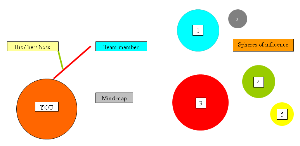Leadership - Influence - Who?
Influence - Who?
Who will you influence?
In order to achieve what you want you must influence people to help you.
How wide does this net stretch and how can you view it?
A good idea is to remember that you are not the only one to influence people and in some cases influence may best be carried out indirectly.
You will need to think about the people you need to influence to reach your vision.
Brain storm
This is a fairly generic technique for coming up with a lot of ideas and is usually carried out in a group. However, there is no reason not to do it just by your self for this exercise. The normal steps can be adapted as:
Step 1Write down what issue or problem you’re trying to resolve.
Step 2Contribute ideas and write them down.
Don’t worry about them at this stage
Evaluate the ideas so far. You may want to consult others here.
Step 6The ideas are then evaluated in a structured manner.
Consider the depth of the individual’s influence.
Mind mapping
This is a simple visual technique where you ‘map’ out those people you will need to influence.
You designate a circle in the middle as ‘yourself’, this acts as the hub of a wheel.
From this you radiate spokes. Each spoke points to a person who you wish to influence to achieve your vision.
These are the obvious ones to think about. However, there are other secondary people that relate to the key personnel on the spokes.
You can then draw other lines from these spokes to represent these secondary people to influence.
In the above case, the primary influence might be ‘Team member’. It is not always the case that a member of your team reports directly to you.
It is very common in project work to have a team from various disciplines. In this case their boss would be a secondary person to influence as necessary.
This technique tells you who but doesn’t give you any feel of the level of influence you may have.
Individuals are all different. The level of influence over one ‘team member’ compared to another will be different.
The hub of the mind map could just as easily be labelled as an ‘issue’ or ‘concern’ that you are trying to resolve.
Make sure, just as in the Brain Storm adaptation, you define it well and write it down.
Spheres of influence
In this system it is a little easier to visualise the strength of influence.
Influence is represented by the boundaries of the spheres and how close they are to each other.
Naturally, the attached levels are objective but will give a good view of the state of play.
In the above example the size of the sphere reflects the level of influence.
For this example, sphere 1 represents the person you wish to influence and sphere 5 could represent you.
Note that your influence is less than the person in sphere 1.
If you are trying to influence person 1 you wish to elicit the help of the person represented by sphere 3.
This could be your boss or number 1’s boss.
You and sphere 4 may be able to join forces to influence 1 or go through 4.
You may have noticed that although person 2 has a small influence he or she is close to 1 and may have additional influence because of this.
This sort of view is easy to record and come back to later.



